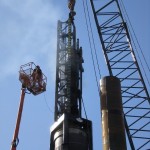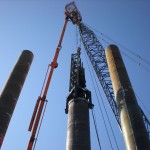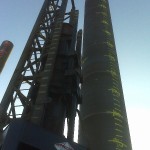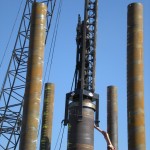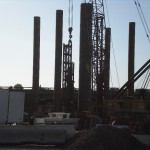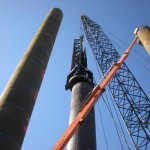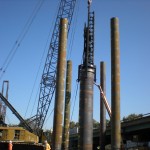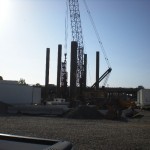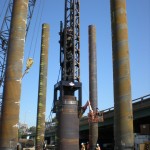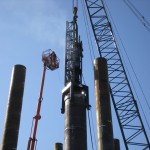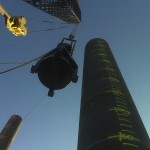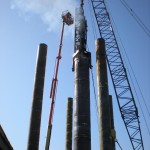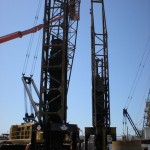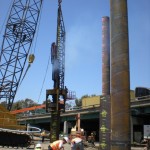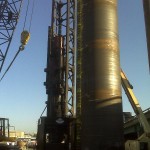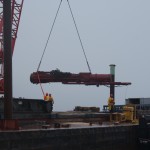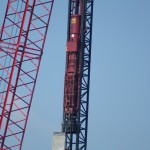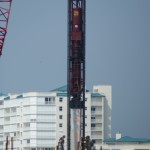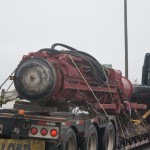Bridge Building in Three Letters = MCM
What can be said of MCM Construction of Northern California? Where can we start when taking a look at one of California’s major bridge builders? Lets see…
1) MCM Construction has built some of the most amazing bridges in California from North to South from start to finish. Massive multi level interchanges that make one dizzy just to look at and beautiful scenic bridges that span 100 foot deep gorges that are wonderful to look at and admire.
2) MCM Construction has Randy Notnagel as Piledriving General Superintendant who just happens to be one of the industry’s leading men in piledriving and foundation work.
3) Jim Carter, owner of MCM Construction, isn’t afraid to tackle any project, even the S.F. BAY BRIDGE APPROACH, which just happens to have 8’ diameter pipe pile driven to depths of 160 feet!
4) MCM Construction of Northern California uses APE equipment to get their pile in the ground!
These are just a few things that make MCM Construction great! Not to mention that they drive GREAT BIG PILES! As seen here, MCM Construction uses the APE model D180-42 single acting diesel hammer with a ram weight of close to 40,000lbs and an energy rating over 450,000ftlbs to drive their MASSIVE eight foot diameter CISS pile. These monster piles are 160 feet long and are being driven into existing bed rock formations for the Oakland California Highway 880 project located in the heart of the city where there are tremendous amounts of traffic every day!
These piles are huge! When the APE D180-42 finished driving the 8 foot diameter pile, the 4 foot diameter reaction piles are driven with his baby brother the APE D100-42. “These piles get bigger and bigger, so the equipment gets bigger and bigger to get the piles driven!” says Randy Notnagel. “The D180 makes the D100 look like a tinker toy.”
We soon forget the days when a big hammer was a D62-22 driving 36” pipe pile. That was huge in the day, but what do you expect when you want to drive across some of the safest bridges in America? Tinker Toys? Those days are gone and that is why MCM Construction uses APE equipment to get their pile in the ground, because if you want to go deep, “Go APE”!
LANE CONSTRUCTION GOES APE ON TITUSVILLE BRIDGE
Lane Construction has been chosen as the design/build contractor for a new bridge over the Indian River in Titusville, Florida. The new bridge is named The Maxwell Brewer Bridge, construction began on June 1.
This 3100-ft long, 4-lane bridge will replace a 2-lane drawbridge which is over 50 years old. The new bridge will eliminate traffic congestion; while speeding hurricane evacuation of the nearby Kennedy Space Center and the surrounding areas including the nudist colony at nearby Canaveral Beach.
The foundations for the bridge and approaches include 64 – 36” square piles over 200 feet long each. There are also 84 – 30” square piles of the same length and 118 – 24” piles. The 36” and the 30” piles are all spliced piles. A spliced pile is usually more difficult to drive correctly because the permitted stress specifications are reduced by approximately 50%. To prevent overstressing the pile, the energy going into the pile from the hammer must be strictly controlled. Lane has chosen an APE D-125 diesel hammer for the 36” piles and an APE D-100 diesel hammer for the 30”. An APE D-62 will drive the 24” piles.
The diesel hammers feature the hydraulic start mechanism and the APE hydraulic fuel system. This system permits finite stroke height control which translates into excellent pile stress reduction.
In addition to the diesel hammers, the project will employ APE vibros for the sheet piling and pile template construction. An APE Model 75 hydraulic earth auger will be used to pre-drill for the 24” piles under the approach slabs.
Lane’s bridge superintendent, Paul Roux states: “ We look to APE to assist us with our pile driving. APE equipment arrives at the jobsite properly prepared, performs flawlessly and, if a problem comes up, APE service technicians always provide prompt and effective product support at the jobsite. Project downtime is minimized.”
Pile installation will continue for the balance of 2009 and should be completed by the end of the year. APE will be there to offer support if needed.







